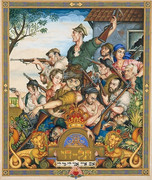Lost Quran archive in Germany
Published by Avi Green on Saturday, January 12, 2008 at 11:04 AM.
A facinating article in the WSJ about an archive of Quranic research that was thought lost for a long time, but has now been found, that shows that there were a lot of German nazis who'd been experts on Islam.
On the night of April 24, 1944, British air force bombers hammered a former Jesuit college here housing the Bavarian Academy of Science. The 16th-century building crumpled in the inferno. Among the treasures lost, later lamented Anton Spitaler, an Arabic scholar at the academy, was a unique photo archive of ancient manuscripts of the Quran.So now, we have some very intriguing evidence of connections between Nazism and Islam. Read the whole thing in full.
The 450 rolls of film had been assembled before the war for a bold venture: a study of the evolution of the Quran, the text Muslims view as the verbatim transcript of God's word. The wartime destruction made the project "outright impossible," Mr. Spitaler wrote in the 1970s.
Mr. Spitaler was lying. The cache of photos survived, and he was sitting on it all along. The truth is only now dribbling out to scholars -- and a Quran research project buried for more than 60 years has risen from the grave.
"He pretended it disappeared. He wanted to be rid of it," says Angelika Neuwirth, a former pupil and protégée of the late Mr. Spitaler. Academics who worked with Mr. Spitaler, a powerful figure in postwar German scholarship who died in 2003, have been left guessing why he squirreled away the unusual trove for so long.
Ms. Neuwirth, a professor of Arabic studies at Berlin's Free University, now is overseeing a revival of the research. The project renews a grand tradition of German Quranic scholarship that was interrupted by the Third Reich. The Nazis purged Jewish experts on ancient Arabic texts and compelled Aryan colleagues to serve the war effort. Middle East scholars worked as intelligence officers, interrogators and linguists. Mr. Spitaler himself served, apparently as a translator, in the German-Arab Infantry Battalion 845, a unit of Arab volunteers to the Nazi cause, according to wartime records.
[...]
The Munich archive began with one of Mr. Nöldeke's protégés, Gotthelf Bergsträsser. As Germany slid towards fascism early last century, he hunted down old copies of the Quran in the Middle East, North Africa and Europe. He took photographs of them with a Leica camera.
In 1933, a few months after Hitler became chancellor, Mr. Bergsträsser, an experienced climber, died in the Bavarian Alps. His body was never given an autopsy; rumors spread of suicide or foul play.
His work was taken up by Otto Pretzl, another German Arabist. He too set off with a Leica. In a 1934 journey to Morocco, he wangled his way into a royal library containing an old copy of the Quran and won over initially suspicious clerics, he said in a handwritten report about his trip.
The Nazis began to use Arabists early in the war when German forces began pushing into regions with large Muslim populations, first North Africa and then the Soviet Union. Scholars were used to broadcast propaganda and to help set up mullah schools for Muslims recruited into the German armed forces.
Mr. Pretzl, the manuscript collector, appears to have worked largely in military intelligence. He interrogated Arabic-speaking soldiers captured in the invasion of France, then, according to some accounts, set off on a mission to stir up an Arab uprising against British troops in Iraq. His plane crashed.








